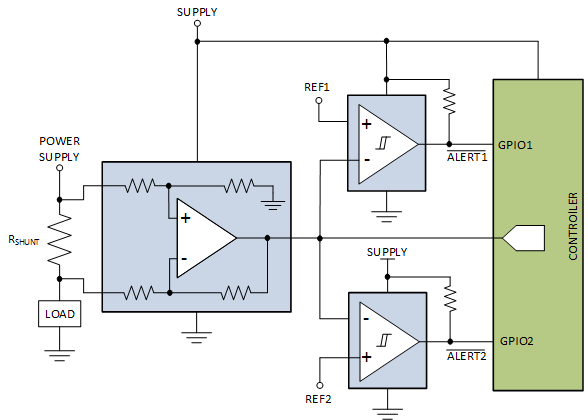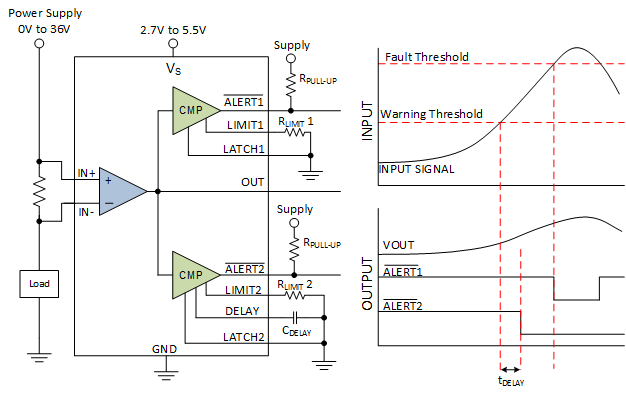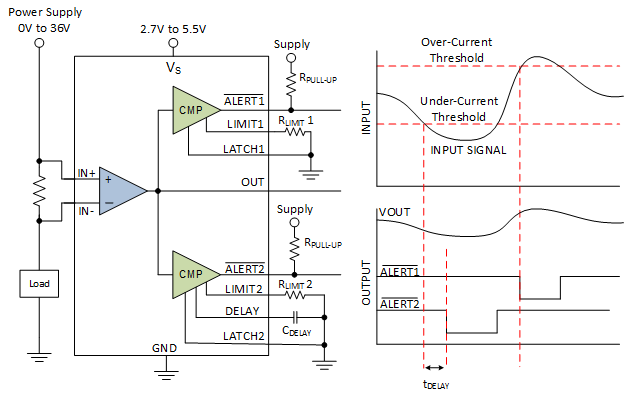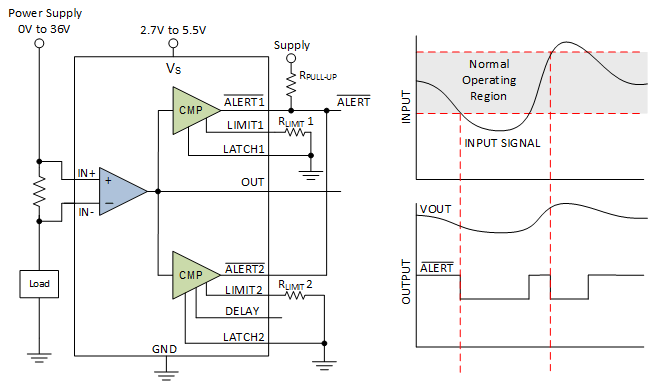SBOA168C May 2018 – October 2021 INA200 , INA200-Q1 , INA201 , INA201-Q1 , INA202 , INA202-Q1 , INA203 , INA203-Q1 , INA204 , INA205 , INA206 , INA207 , INA208 , INA209 , INA233 , INA300 , INA300-Q1 , INA301 , INA301-Q1 , INA302 , INA302-Q1 , INA303 , INA303-Q1 , INA381 , INA381-Q1
One of the first parameters engineers look at when determining proper operation of a PCB design is the operating current. By examining the operating current, an engineer can immediately tell if something on the board is shorted, whether any of the devices are damaged, and in some cases detect if the software is running as expected. The traditional approach of using a current sense amplifier + ADC to monitor current for out-of-range conditions does not provide the required alert response time. Also, use of an ADC to monitor over current alert thresholds requires constant communication between the ADC and host processor which can unnecessarily burden the system.
Being able to quickly know when a current level is out of range allows improved safely, improved system intelligence/diagnostics and reduced downtime.
To address the response time required for out-of-range current conditions, analog comparators are needed to detect when the current exceeds a given reference threshold. However, in many cases having only one alert level is insufficient to determine the system status and provide appropriate system responses to out-of-range currents. To handle this requirement the circuit shown in Figure 1-1 can be used to monitor multiple out-of-range current conditions.
 Figure 1-1 Discrete Implementation to
Detect Multiple Over-current Events
Figure 1-1 Discrete Implementation to
Detect Multiple Over-current EventsThis circuit is composed of 5 devices: a current sense amplifier, two comparators, and two references. The discrete implementation, shown in Figure 1-1 requires careful selection of the comparators to get the desired alert response time. Slow response times may not allow enough time for the system to take action; while too fast of a response time can trigger false alerts, possibly resulting in system shutdown.
Figure 1-2 shows a simpler circuit that addresses the design issues present in the discrete implementation.
 Figure 1-2 INA302 Multi-Alert Over-Current Comparator
Figure 1-2 INA302 Multi-Alert Over-Current ComparatorThe INA302 incorporates the ability to detect two out-of-range conditions. The lower out-of-range condition is referred to as the over current warning threshold, while the higher out-of-range condition is referred to as the over current fault threshold. The over current warning threshold allows detection when the current is starting to get too high but has not yet reached the fault threshold where system shutdown may be initiated. When the current exceeds the warning threshold, the system may opt to reduce the system power consumption by disabling sub-circuits, controlling supply voltages, or reducing clocking frequencies to lower the total system current to prevent a fault condition. If an over-current fault condition does occur, it is important to respond quickly to prevent further system damage or malfunctioning behavior.
To minimize the component count and facilitate ease of use, the alert thresholds of the INA302 are set with single external resistors. The fault threshold should be set higher than the worst case current the system could be expected to consume. When the current exceeds this threshold, the alert pin of the INA302 will respond within 1 μs. The value for the warning threshold is application dependent, but is usually higher than the nominal operating current. The response time of the warning threshold is adjustable with an external capacitor from 3 μs to 10 s.
By setting the warning threshold delay time appropriately, it is possible to set the over-current warning threshold closer to the maximum DC operating current while still avoiding false trips due to brief current spikes or noise. Wider separation between the fault and warning thresholds provides the system additional time for preventative action before the fault threshold is exceeded.
Some systems allow operation above the warning threshold for a period of time before triggering an alert. One such application is monitoring the supply current to a processor. The processor may be allowed to operate above the normal maximum current level for a brief period of time to maximize computing throughput during critical operations. If the current is above the warning threshold when the set delay expires the alert output will pull low to notify the host processor so the voltage or clocking frequency can be decreased before overheating occurs.
In some systems it is beneficial to detect when the current is too low. For these applications, the INA303, shown in Figure 1-3 provides both over and under current detection.
 Figure 1-3 INA303 Over and Under Current Detection
Figure 1-3 INA303 Over and Under Current DetectionWhen the current exceeds the over current fault threshold, the ALERT1 output will respond within 1 μs. However, if the current goes below the under current threshold, the ALERT2 response time is set by the delay capacitor. Undercurrent situations may briefly occur in normal operation; however, if this condition persists, it could be due to a damaged device or system that is about to fail.
In this case, the alert output can notify the system of this condition and fault handling procedures can be implemented before system failure.
Another use of under-current detection is to provide confirmation of proper system status. Some systems go into low power modes where the current is below the normal operating range. In this case, the under-current alert output can be used to notify the host that the system has indeed entered the shutdown state.
Some designs may only care to get notified if the current is outside of expected operating bounds. For these cases, the INA303 can be configured to run in window mode by connecting the two alert outputs together as shown in Figure 1-4. In this mode, the single alert output will be high as long as the current is with-in the normal operating window.
 Figure 1-4 INA303 Window mode Operation
Figure 1-4 INA303 Window mode OperationAlternate Device Recommendations
The INA226 can be used in applications that require digital current monitoring. If only a single digital alert output is needed, the INA300 provides an optimal solution in a tiny 2mm x 2mm QFN package. For applications that only require a single alert output in additional to the analog current signal, the INA301 provides excellent current monitoring accuracy with an alert response less than 1 μs. For cost sensitive applications and added flexibility, the INA381 provides an current sense amplifier with an internal comparator with accessible inputs.
| Device | Optimized Parameter | Performance Trade-off |
|---|---|---|
| INA301 | MSOP-8 package, single alert with analog monitor. | Single alert |
| INA300 | 2mm x 2mm QFN package | Alert only |
| INA381 | Cost effective, accessible comparator inputs | Single alert |
| INA226 | Digital current monitor | N/A |